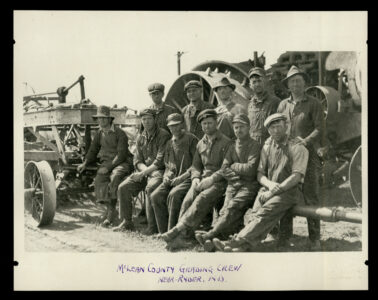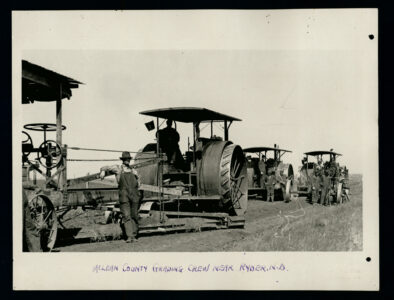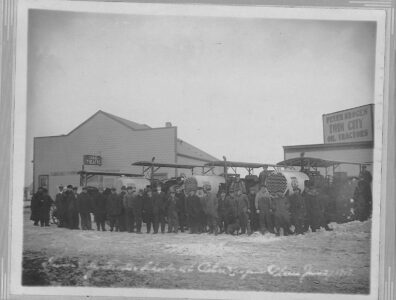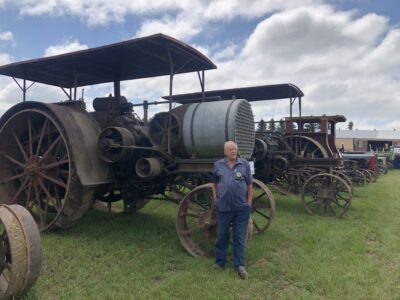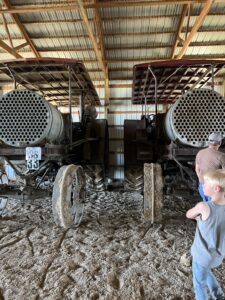Peterson Farm conveys story of early ND pioneers
Makoti Threshers feature twin set of 30-60 Aultman & Taylor tractors
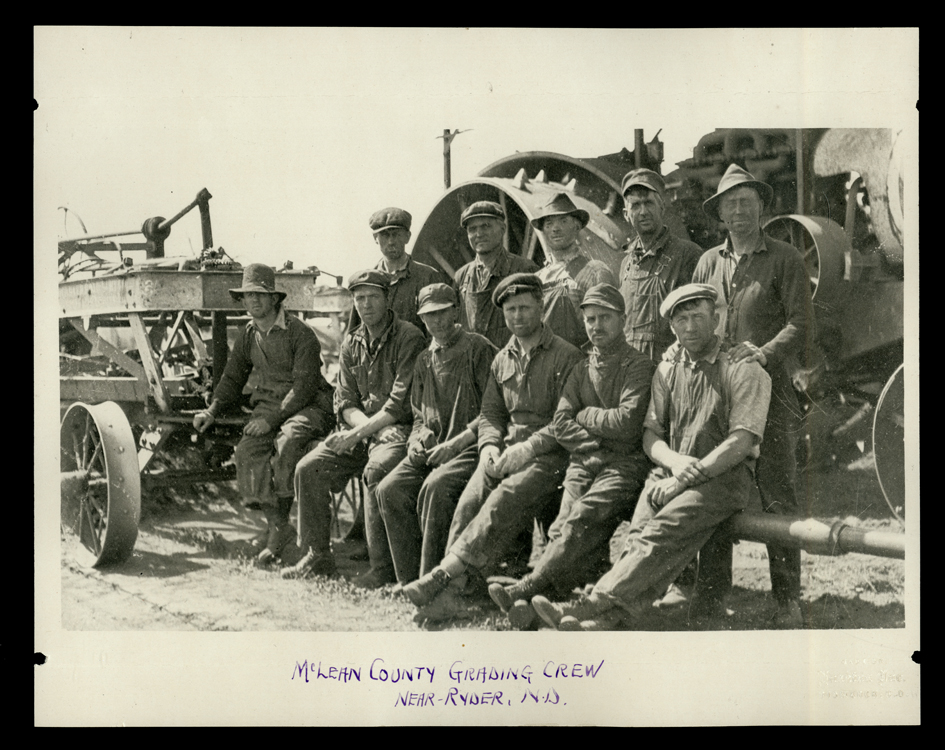
Submitted Photo Men of the McLean County Grading Crew pose for a picture while grading King’s Highway south of Ryder. They are sitting in front of a 30-60 Aultman & Taylor that is thought to have been the one Petersons’ neighbors owned at the time. According to Don Peterson, it got cut up, thrown into a Soo Railroad car in Ryder, and sold for scrap during World War II. Photo was taken by Hoskins-Meyer Photography of Bismarck on June 10, 1921. Photo courtesy of the State Historical Society of North Dakota.
RYDER – A family in Blue Hill Township has a rich history in farm machinery that can transport a person back in time.
Now, Dana Peterson and his father, Don Peterson, live on their family farm south of Ryder, about a mile and a half from the Ward County/McLean County line. The fields of the Peterson Farm may be sown and worked with a Versatile quad-track today; however, the iron mammoths that originally broke the sod of those same fields, and much of the surrounding area over a century ago, hold a story unlike any other.
Harry Peterson, his brother Roy, and their father Ed, came to the Ryder area from Minnesota in the early 1900s. Roy, a bachelor, especially had a gift when it came to tractors – they were his true love.
“Harry was my grandpa, and Roy was my great uncle,” Dana Peterson said. “The two brothers moved up here from Lake Benton, Minnesota, and started the Peterson Farm. Grandpa and Great Uncle Roy owned the Aultman & Taylor tractors together and farmed together with them. They have been a staple in Makoti’s Threshing Bee for years.”
Dana said Harry and Roy, and their dad Ed, farmed about 1,600 acres, which was a massive amount of land to farm back in that time.
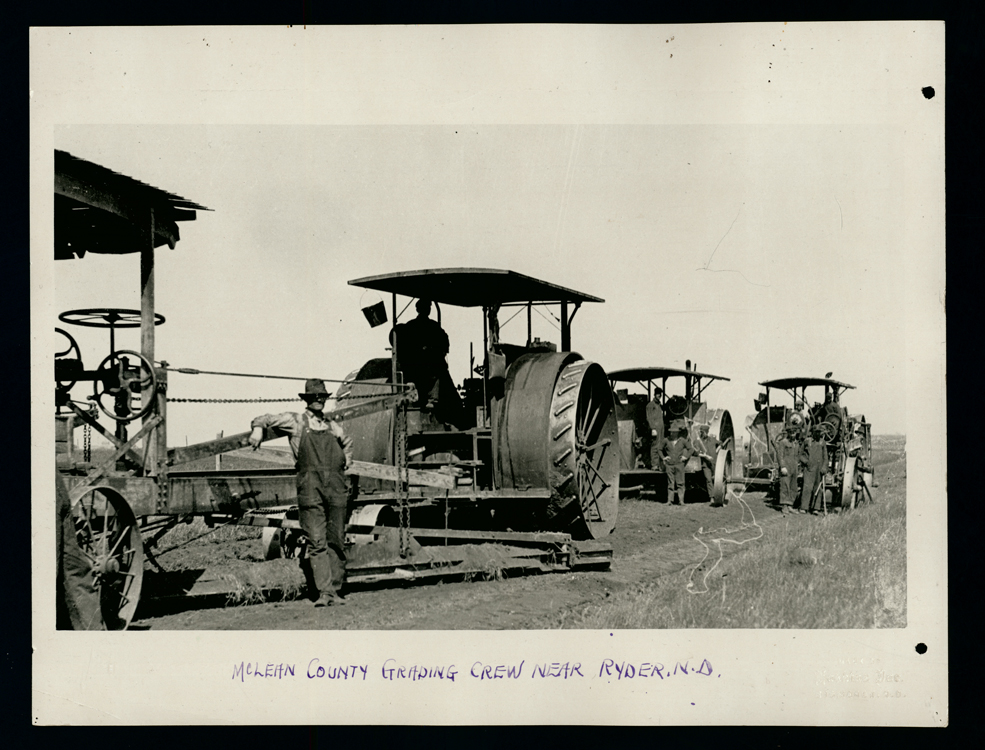
Submitted Photo In foreground is the 30-60 Aultman & Taylor that is thought to be the tractor that the Hopkins Family owned and sold for scrap during World War II. In the background, is the twin set of Twin City 40-65 tractors. This photo is likely the only one in existence in which two Twin City tractors are seen working together. Photo was taken by Hoskins-Meyer Photography of Bismarck on June 10, 1921. Photo courtesy of the State Historical Society of North Dakota.
“The two 30-60 Aultman & Taylor tractors they used were basically twins – not too many serial numbers apart and were made, we believe, in around 1918,” Dana said. “The price they paid for the first one was $4,000. The second one came from down by Garrison. My dad said he was with Roy when he went down to get it.
“Nick Ruter owned it,” he said, unsure of the name spelling. “They only paid around $300 for that second one, and that was way later on, around 1946 after World War II my dad said.”
The first tractor is believed to have come from Monango, which is about halfway between Edgeley and Ellendale.
“On June 26, 1922, Roy wrote a letter to M. M. Cook about Cook’s Aultman & Taylor in Monango. We assume that’s where the first one came from. That first one saw a lot more work on our farm than the other one.”
Scott Vouk of St. Stephen, Minnesota, is an enthusiast in old tractors and has been helping Dana work on the twin set of Aultman & Taylors in Makoti the last few years. Vouk said the two also love giving each other a hard time, but it’s all in fun.
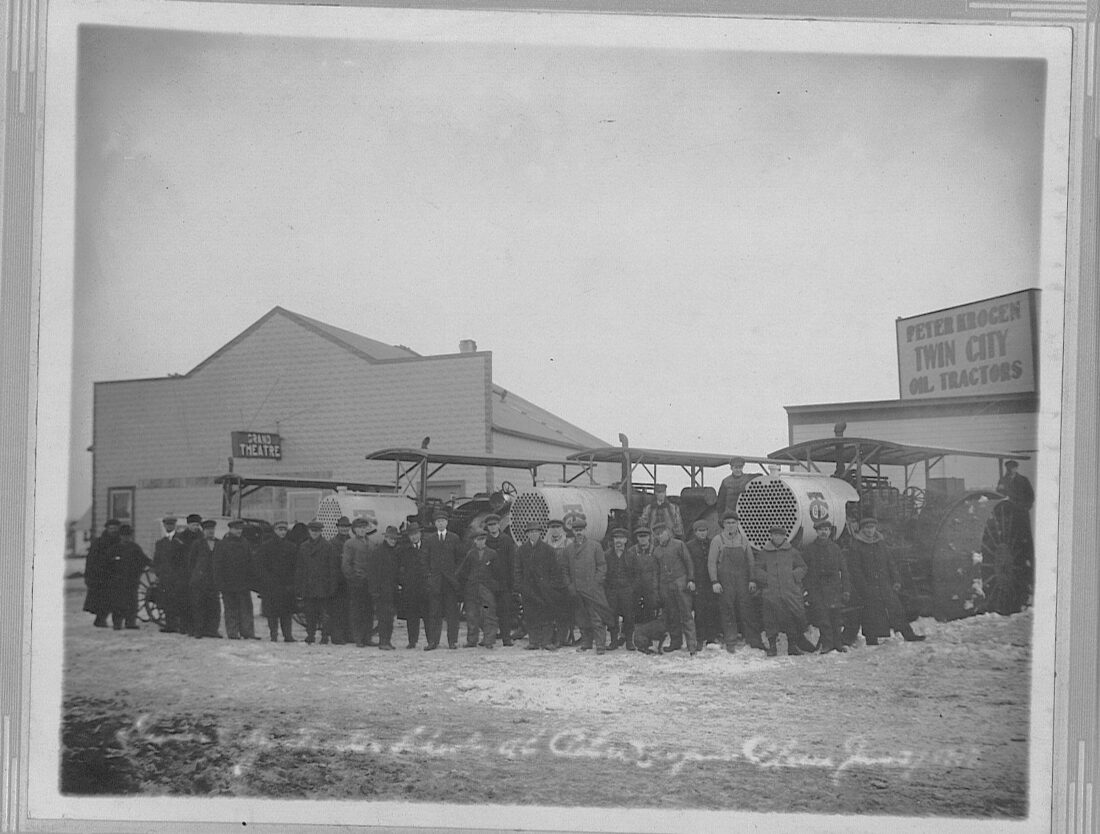
Submitted Photo Scott Vouk, of St. Stephen, Minn., describes this image as truly incredible – a lineup of Twin City Tractors in Parshall. From left to right is a 15 Twin City, a 25 Twin City, a 40 Twin City, and a 60 Twin City. Vouk is 99% certain that the 40 Twin City (second tractor from the right) on the is one of the two tractors that Roy Peterson of Ryder purchased. Vouk believes that Roy purchased both in Parshall.
“I’ve only known Scott a few years,” Dana said. “He clearly knows way more about my family and our tractors than I do. I can give him a part number off a gear on an Aultman Taylor or a Case steam engine, and he’ll tell me exactly where it goes. The one Aultman Taylor I have didn’t run well at all. It missed and clanked and banged and was hard on spark plugs, but Scott said we’re doing to fix this, darn it, and so we did. I helped Scott take the heads off of the one tractor, and he took them home and completely rebuilt them.”
Don Peterson remembers when the tractors were used in the fields and when the heads were off the Monango tractor in the 1930s. He said it was definitely time for them to be worked on again.
“The heads they put on there, my uncle Roy would go to junkyards – around the time they were destroying everything for scrap for the war – and found two heads,” Don said. “We still have the originals he replaced.”
Don said a lot of those old tractors that were around the countryside got junked, and he remembers a story from around 1944.
“It was during the war,” he said. “These scrap dealers wanted old tractors for nothing and then would turn around and make a fortune off them for scrap metal. We were out in the field and a Rodahl boy from down south a little ways was helping us. I was pretty young, but this scrap dealer came out there and wanted to take some of our tractors. He got pretty mean about it. At one point the man asked the Rodahl boy, ‘Shouldn’t you be in the service!’ The boy responded, ‘I’m going in two weeks.’ And then the man finally left. The Rodahl boy was later killed in the war.”
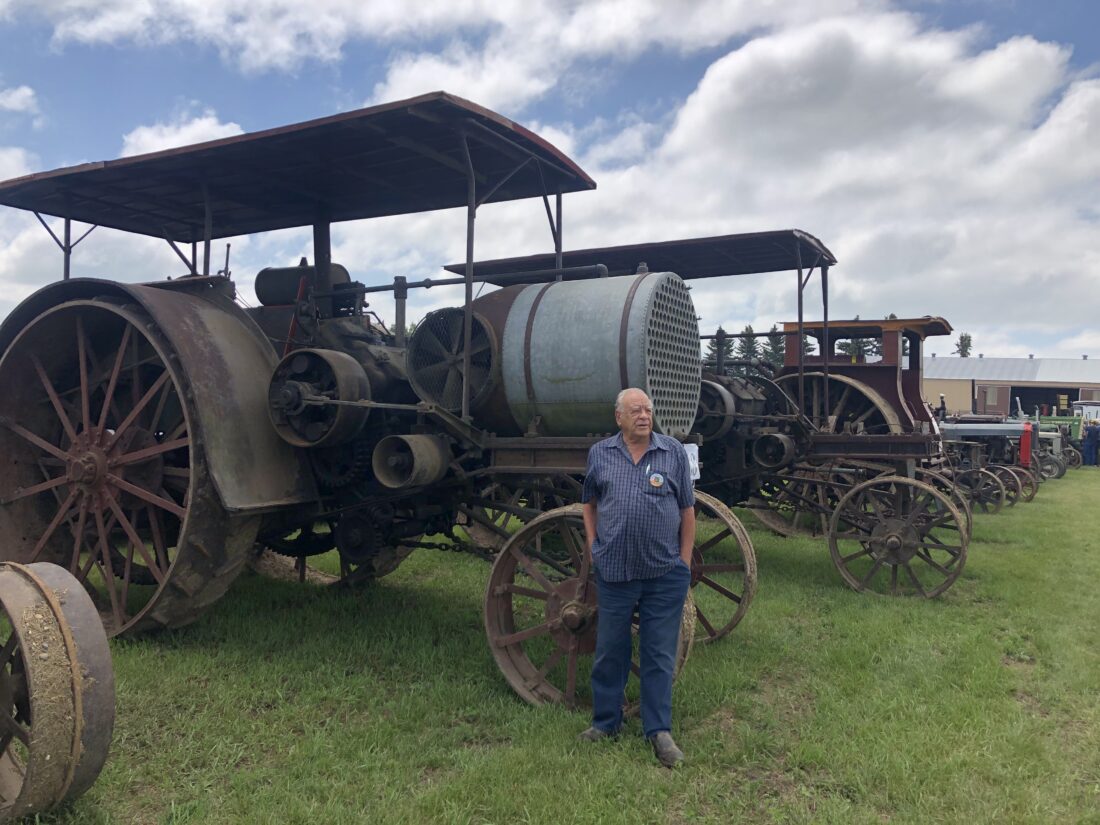
Don Peterson stands in front of the family’s two 30-60 Aultman & Taylor tractors in Makoti. The one on the left came from near where Camp of the Cross is today and was purchased in 1946. The other, behind Peterson, is the one that took over work for the Twin City tractors on the Peterson Farm. Roy Peterson is said to have bought it from M. M. Cook at Monango in 1922.
Don said the scrap dealer showed up again a little later on and apologized for how he had acted.
“The 30-60 Aultman Taylor is a very well-built tractor,” Vouk said. “But the first tractor especially, was used hard, and you could say it needed some elbow grease. The heads got new valves, new seats and new springs. I also made new guides and pressed them in the heads. I bored and bushed the rocker arms, as well. I wouldn’t say this was hard work, but I will say Dana better be appreciative of all the time I put into this.”
Dana laughed at Vouk’s comment and the two continued to go back and forth with more jests and laughs.
“These two tractors – they’re not as rare as the Twin City tractors we used to have, but they tell the story of our local farming history,” Dana said. “My dad tells the story of how Uncle Roy would hook up the 10-bottom plow and drive the 30-60 he bought down by Garrison to Makoti for the parade and then drive it back home again each year. He did this for Makoti’s first parade in 1961 and then continued in the following years for the Makoti Threshing Bee. Well, let’s just say I’m not quite as ambitious as Roy was, so now both 30-60s just stay in Makoti year around.”
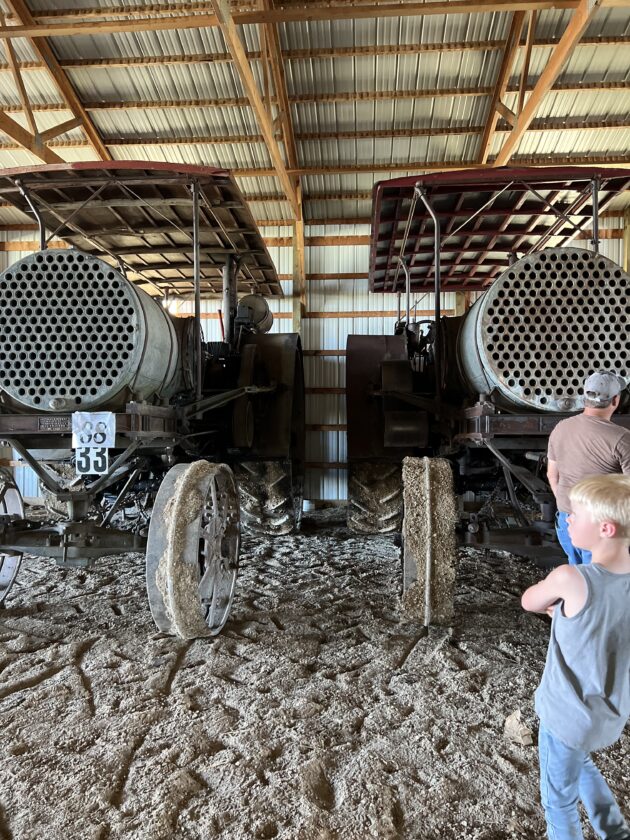
The Petersons’ two 30-60 Aultman Taylors sitting side by side in Makoti. The one on the left came from near Garrison and the one on the right came from Monango in southeastern North Dakota.
Twin City tractors
What cannot be seen in Makoti, unfortunately, are the two Twin City tractors that broke the sod in much of Blue Hill Township and probably most of the land south of Ryder.
Vouk is an enthusiast in Twin City tractors. It would be safe to say he knows their history, and how they run, inside and out.
“Roy and Harry Peterson bought two presumably new 40-65 Twin City tractors out of Parshall, North Dakota, in 1916, and used them for plowing, threshing and road grading,” Vouk said. “Without the Twin City tractors, the Petersons wouldn’t have been as successful as they were.”
The Twin City tractor was the Cadillac of tractors, according to Vouk. He said they cost two or three times any other tractor back in that day.
“It was really underheard of for farmers to have them. Townships, counties, and municipalities were the only ones who could really afford them,” Vouk said. “The Petersons had two, and they used them until they basically couldn’t use them anymore. That’s when they bought the first Aultman & Taylor from M. M. Cook near Monango.”
Vouk said Roy had gone to tractor school in Fargo, so he knew exactly what he was buying, and this is probably why he spent the money on the best of the best.
“Those Twin City tractors are a level above the rest,” he said. “If you get on one, and then get on another from that era, you will see the difference. What the Peterson Farm had was truly amazing.
“It wasn’t even just their tractors though. Since they had two of these tractors, they had two threshing rigs and two cookcars,” according to Vouk and reaffirmed by Don. “Each cookcar had a telephone, and they’d hook into the telephone lines and be able to know where each threshing rig was at and be able to keep track of one another. Truly unreal. Don and Dana still have one of the cookcars out at their place.”
Vouk said it was too bad the Twin City tractors got sold at auction in the 1980s. But he said there was hardly anything left of them because they had been worked so hard, so at the time, it probably made sense to sell them.
“Roy had accumulated rows of old tractors out there in his later years,” Vouk said. “Toward the end, he’d just keep buying them because they were his passion. The Peterson Farm had an auction in 1983 because I’m sure it was just too much. Mostly everything got sold and dispersed around the country. Harry liked the two Aultman & Taylors, so they stayed in Makoti.”
Don said Roy picked up a lot of old Hart Parr tractors, a Rock Island, some Allis Chalmers, and other tractors such as that.
“Roy was in the nursing home, and my dad wasn’t well, so we wanted to get rid of the tractors before estates got involved,” Don said. “It’s easier to divide money than property. That was the reason for the sale. Both Roy and Harry died in 1985.”
Rarity
To help put the rarity in perspective, only twelve 40-65 Twin City tractors remain in existence. Two of them were the ones on the Peterson Farm. They must have been special in their prime as well because on June 10, 1921, Hoskins-Meyer Photography in Bismarck took photographs of the tractors grading King’s Highway south of Ryder.
“I’m not going to sugarcoat it,” Vouk said. “The fact that the Peterson Farm had two of these Twin City tractors is incredible. The fact that Parshall had a Twin City dealership was amazing. And the fact that both of those Peterson family Twin City tractors are still in existence today is remarkable.”
The photograph for the Twin City dealership in Parshall, and the photos of the McLean County Grading Crew are unlike anything he’s ever seen, he said.
“Both tractors are still in drivable condition. I know exactly who owns them and where they’re located. One is in Connecticut and the other is in Idaho. If Dana wasn’t so darn stingy, he’d have them both back in Makoti by now so I could help restore them,” he joked.
- Submitted Photo Men of the McLean County Grading Crew pose for a picture while grading King’s Highway south of Ryder. They are sitting in front of a 30-60 Aultman & Taylor that is thought to have been the one Petersons’ neighbors owned at the time. According to Don Peterson, it got cut up, thrown into a Soo Railroad car in Ryder, and sold for scrap during World War II. Photo was taken by Hoskins-Meyer Photography of Bismarck on June 10, 1921. Photo courtesy of the State Historical Society of North Dakota.
- Submitted Photo In foreground is the 30-60 Aultman & Taylor that is thought to be the tractor that the Hopkins Family owned and sold for scrap during World War II. In the background, is the twin set of Twin City 40-65 tractors. This photo is likely the only one in existence in which two Twin City tractors are seen working together. Photo was taken by Hoskins-Meyer Photography of Bismarck on June 10, 1921. Photo courtesy of the State Historical Society of North Dakota.
- Submitted Photo Scott Vouk, of St. Stephen, Minn., describes this image as truly incredible – a lineup of Twin City Tractors in Parshall. From left to right is a 15 Twin City, a 25 Twin City, a 40 Twin City, and a 60 Twin City. Vouk is 99% certain that the 40 Twin City (second tractor from the right) on the is one of the two tractors that Roy Peterson of Ryder purchased. Vouk believes that Roy purchased both in Parshall.
- Don Peterson stands in front of the family’s two 30-60 Aultman & Taylor tractors in Makoti. The one on the left came from near where Camp of the Cross is today and was purchased in 1946. The other, behind Peterson, is the one that took over work for the Twin City tractors on the Peterson Farm. Roy Peterson is said to have bought it from M. M. Cook at Monango in 1922.
- The Petersons’ two 30-60 Aultman Taylors sitting side by side in Makoti. The one on the left came from near Garrison and the one on the right came from Monango in southeastern North Dakota.

